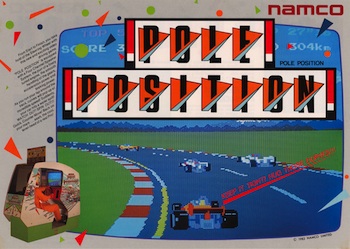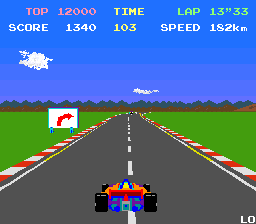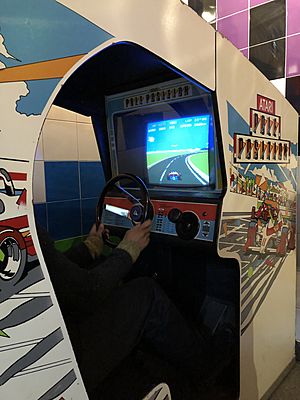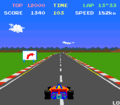Pole Position facts for kids
Quick facts for kids Pole Position |
|
|---|---|

Advertising flyer
|
|
| Developer(s) | Namco |
| Publisher(s) |
|
| Designer(s) | Kazunori Sawano Sho Osugi Shinichiro Okamoto |
| Programmer(s) | Koichi Tashiro |
| Composer(s) | Nobuyuki Ohnogi Yuriko Keino |
| Platform(s) | Arcade, Atari 2600, Atari 5200, Atari 8-bit, Commodore 64, TI-99/4A, VIC-20, Vectrex, Mobile phone |
| Release date(s) |
|
| Genre(s) | Racing (simulation) |
| Mode(s) | Single-player |
Pole Position is a classic arcade racing game. It was made by Namco in 1982. Atari, Inc. helped release it in the United States. The game runs on a special arcade system board called the Namco Pole Position. Many people think it's one of the most important games from the "golden age" of arcade games. Pole Position was an improved version of Namco's older racing games, like F-1 from 1976. Sho Osugi, who designed F-1, also helped create Pole Position.
The game was a huge success in arcades. It became the highest-earning arcade game of 1982 in Japan. Then, it became the most popular coin-operated arcade game worldwide in 1983. In North America, it was the top-earning arcade game for two years, in 1983 and 1984. It was even one of the top five arcade video games of 1985.
Pole Position was the most successful racing game of its time. It led to many versions for home consoles, sequels, and even a Saturday morning cartoon. The game set the standard for how racing games would be made. Its success also inspired many other games to copy its style. Pole Position is seen as one of the most important video games ever, especially for racing games. Its sequel, Pole Position II, came out in 1983.
Contents
How to Play Pole Position
In Pole Position, you control a Formula One race car. First, you need to complete a special lap called a time trial. You have a certain amount of time (from 57 to 120 seconds) to finish this lap. If you do, you qualify for the main F1 race at the Fuji Racetrack.
After qualifying, you race against seven other cars controlled by the computer. If you don't qualify, your car stays on the track until your time runs out. During the race, you must avoid driving off the road. If you do, you might crash into the billboards along the track. The game ends when you run out of time on any lap or when you finish all four laps of the race.
Pole Position was the first racing video game to use a track based on a real racing circuit. It was also the first game to have a qualifying lap. This meant players had to prove their skill before joining the main Grand Prix races. Once qualified, you had to finish the race within a time limit. You also had to avoid crashing into other cars or billboards.
Atari, the game's distributor in North America, praised the game for its "unbelievable driving realism." It felt like a real Formula 1 experience with a racing wheel. The game's graphics showed colorful landscapes. It used scaling sprites for cars and signs. This made them look like they were moving in a pseudo-3D world. The view was from behind your car, looking forward. The track's end point would sway as you turned corners. This made it feel like you were really moving into the distance. Earlier 3D driving games focused on staying on the road. But Pole Position gave bigger rewards for passing rival cars and finishing near the front.
Game Cabinets
Pole Position came in two main types of arcade machines. One was a standard upright cabinet. The other was a special "environmental" or cockpit cabinet. Both versions had a steering wheel and a gear shifter. The shifter let you choose between low and high gears. The cockpit cabinet also had both an accelerator and a brake pedal. The standard upright cabinet only had an accelerator pedal.
How the Game Was Made
Pole Position was created by Shinichiro Okamoto and Kazunori Sawano, who also designed Galaxian. Sho Osugi, an engineer who worked on Namco's older driving games, also helped. Namco had experience making coin-operated driving games in the 1970s, like F-1. Sawano showed Okamoto his ideas for a new video racing game, and Okamoto liked it.
Okamoto wanted the game to feel like a real driving simulation. He wanted it to use a 3D view. He also wanted players to be able to use real driving techniques. He chose to include the Fuji Speedway in the game. This was so new players would recognize it. The music for the game was made by Nobuyuki Ohnogi and Yuriko Keino.
Making the game took three years. Okamoto said the hardest part was creating the special computer hardware needed. The game was very "ambitious" and needed more power than older machines. The team used two 16-bit processors to run the game. Okamoto said this was very new for arcade games at the time. For a while, it was the only video game to use a Z8000 CPU.
Toru Iwatani, who created Pac-Man, chose the name Pole Position. He thought it sounded "cool" and catchy. He quickly registered the name as a trademark. The controls were also a challenge. Okamoto wanted them to feel realistic and match the gameplay. Osugi remembered that Namco's president, Masaya Nakamura, had trouble keeping the car straight.
The game's arcade cabinet was a sit-down "environmental" machine. This type of machine was popular at the time. The development team had long discussions about how fast the gear-shift should be. In the end, they decided to keep it simple, with just high or low speed.
Game Release
Pole Position was first released in Japan on September 16, 1982. It was then licensed to Atari, Inc. for release in North America. It first appeared at a show in Chicago in November 1982. It was widely released in North America on November 30, 1982. Namco itself released the game in Europe in late 1982. After Pole Position came out, Osugi said that all of Namco's older driving games were stopped. The company saw that video games were the future of arcade racing.
Advertising the Game
This game was one of the first to use product placement. This means real company names were shown in the game. You could see billboards around the track advertising actual companies.
The game was also shown in a TV commercial on MTV. This was part of a series of TV ads that Atari made for MTV in the 1980s.
Game's Impact
Pole Position was the most successful racing game of the classic era. It led to many versions for home systems, sequels, and even a Saturday morning cartoon.
The game also inspired many other games to copy its style. For example, Top Racer from Commodore International was very similar. This led to a lawsuit from Namco against Commodore Japan. As a result, copies of Top Racer were taken away.
Other Media
The game led to a Saturday morning cartoon of the same name.
Parker Brothers also made a Pole Position board game in 1983.
Images for kids
See also
 In Spanish: Pole Position (videojuego) para niños
In Spanish: Pole Position (videojuego) para niños






